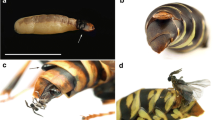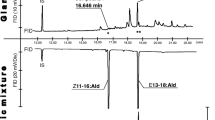Abstract
4-Methyl-5-nonanol (1) is the male-produced aggregation pheromone of the palm weevil, Dynamis borassi (F.) from Colombia. The pheromone was identified by coupled gas chromatographic–electroantennographic detection (GC-EAD) analysis of male- and female-produced volatiles, and comparative GC–mass spectrometry (MS) of weevil-produced 1. In field experiments in Colombia, traps baited with a stereoisomeric mixture of synthetic 1 (3 mg/day) plus sugarcane captured more weevils than traps baited with 1 or sugarcane alone, suggesting that pheromone and plant volatiles are synergistically attractive. Use of a chiral, stereoisomer-separating Cyclodex-B column in GC-EAD and GC-MS analyses revealed that D. borassi males produce, and antennae of males and females respond to (4S,5S)-1. Previously identified palm weevil (Rhynchophorus spp.) aggregation pheromones 5-methyl-4-octanol (cruentol) and 6-methyl-2-hepten-4-ol (rhynchophorol) also elicited antennal responses by D. borassi. In field experiments, D. borassi females were captured equally well in traps baited with sugarcane plus either 1, cruentol or rhynchophorol. In contrast, D. borassi males were captured most often in traps baited with sugarcane plus 1. Because D. borassi is a potential vector of the red ring nematode that causes the lethal red ring disease of palms, pheromone-based trapping of D. borassi could aid in monitoring or management of red ring disease in commercial palm plantations.
Similar content being viewed by others
REFERENCES
ARN, H., STADLER, E., and RAUSCHER, S. 1975. The electroantennographic detector—a selective and sensitive tool in the gas chromatographic analysis of insect pheromones. Z. Naturforsch, 30c:722–725.
BONDAR, G. 1940. Insectos nocivos e molestias do coqueiro (Cocos nucifera) no Brazil. Inst. Cent. Fom. Econ. Bahia, Bol. 8:1–160.
GERBER, K., GIBLIN-DAVIS, R. M., and ESCOBAR-GOYES, J. 1990. Association of the red ring nematodc, Rhadinaphelenchus cocophitus, with weevils from Ecuador and Trinidad. Nema-tmpica 20:39–49.
GIBLIN-DAVIS, R. M., OEHLSCHLAGER, A. C., PEREZ., A. L., GRIES, G., GRIES, R., WEISSLING, T. J., CHINCHILLA, C. M., PEŇA, J. E., HALLETT, R. H., PIERCE, H. D., JR., and GONZALEZ, L. M. 1996. Chemical and behavioral ecology of palm weevils (Curculionidae: Rhyncho-phorinae). Fla. Entomol. 79:153–167.
GRIES, G., GRIES, R., PEREZ, A. L., OEHLSCHLAGER, A. C., GONZALES, L. M., PIERCE, H. D., JR., Kouda, M., ZKBEYOU, M., and NANOU, N. 1993. Aggregation pheromone of the African palm weevil, Rhynchophorus phoenicis F. Naturwissenschaften 80:90–91.
HALLETT, R. H., GRIES, G., GRIES, R., BURDEN, J. H., CZYZEWSKA, E., OEHLSCHLAGER, A. C., PIERCE, H. D., JR., ANGERILLI, N. P. D., and RANF, A. 1993. Aggregation pheromone of two Asian palm weevils, Rhynchophorus ferrugineus and R. vulneratus. Naturwisscnschaflen 80:328–331.
LANDEIRO, R. 1941. Dynamis polilus Gyll. (Rhynchophorus politus Gyll.) Uma nova praga do coqueiro. Bol. Minim. Agric. Ind. Com., Rio de Janeiro 30:1–6.
OEHLSCHLAGER, A. C., PIERCE, A. M., PIERCE, H. D., JR., and BORDEN, J. H. 1988. Chemical communication in cucujid grain beetles. J. Chcm. Ecol. 14:2071–2098.
OEHLSCHLAGER, A. C., PIERCE, H. D., JR., MORGAN, B., WIMALARATNE, P. D. C., SLESSOR, K. N., KING, G. G. S., GRIES, G., GRIES, R., BORDEN., J. H., JIRON, L. F., CHIINCHILLA, C. M., and MEXZAN, R. G. 1992. Chirality and field activity of rhynchophorol, the aggregation pheromone of the American palm weevil. Naturwissenschaften 79:134–135.
OEHLSCHLAGER, A. C., PRIOR, R. N. B., PEREZ., A. L., GRIES, R., GRIES, G., PIERCE, H. D., JR., and LAUP, S. 1995. Structure, chirality, and field testing of a male-produced aggregation pheromone of Asian palm weevil Rhynchophorus bilineatus (Montr.) (Coleoptera: Curculion-idae). J. Chem. Ecol. 21:1619–1629.
PEREZ, A. L., GRIES, G., GRIES, R., GIBLIN-DAVIS, R. M., and OEHLSCHLAGER, A. C. 1994. Pheromone chirality of the African palm weevil, Rhynchophorus phoenicis (F.) and the pal-metto weevil, Rhynchophorus crucntatus (F.) (Coleoptera: Curculionidae). J. Chem. Ecol. 20:2653–2671.
PEREZ, A. L., HALLETT, R., GRIES, R., GRIES, G., OEHLSCHLAGER, A. C., and BORDEN, J. H. 1996. Pheromone chirality of Asian palm weevils, Rhynchophorus ferrugineus (Oliv.) and Rhynchophorus vulneratus (Panz.) (Coleoptera: Curculionidae). J. Chem. Ecol. 22:357–368.
PEREZ, A. L., CAMPOS-PIEDRA, Y., CHINCHILLA, C. M., OEHLSCHLAGER, A. C., GRIES, G., GRIES, R., CASTRILLO, G., GIBLIN-DAVIS, R. M., PEžA, J. E., DUNCAN, R. E., GONZALEZ, L. M., PIERCE, H. D., JR., MC DONALD, R., and ANDRADE, R. 1997. Aggregation phcromones and host kairomones of the West Indian sugarcane weevil, Metamasius hemipterus sericeus (Oliv.) (Coleoptera: Curculionidae). J. Chem. Ecol. 23:869–888.
RAMIREZ-LUCAS, P., MALOSSE, C., DUCROT, P. H., LETTERE. M., and ZAGATTI, P. 1996. Chemical identification, electrophysiologieal and behavioral activities of the pheromone of Metamamsius hemipierus (Coleoptera: Curculionidae). Bioorg. Med. Chem. 4:323–368.
RAMIREZ-LUCAS, P., ROCHAT, D., and ZAGATTI, P. 1996. Field trapping of Metamasius hemipterus with synthetic aggregation pheromone. Entomol. Exp. Appl. 80:453–460.
ROCHAT, D., MALOSSE, C., LETTERE, M., DUCROT, P. H., ZAGATTI, P., RENOU, M., and DESCOINS, C. 1991. Male-produced aggregation pheromone of the American palm weevil, Rhynchophorus palmarum (L.) (Coleoptera: Curculionidae): Collection, identification, electrophysiologieal activity, and laboratory bioassay. J. Chem. Ecol. 17:2127–2140.
SAS INSTITUTE. 1985. SAS User's Guide: Statistics, 5th ed. SAS Institute, Gary, North Carolina.
WATTANAPONGSIRI, A. 1966. A revision of the genera Rhynchaphorus and Dynamis (Coleoptera: Curculionidae). Department of Agricultural Science Bulletin, Bangkok 1:1–328.
WEISSLING, T. J., GIBLIN-DAVIS, R. M., GRIES, G., GRIES, R., PEREZ, A. L., PIERCE, H. D., JR., and OEHLSCHLAGER, A. C. 1994. Aggregation pheromone of palmetto weevil Rhynchophorus cruentalus (F.) (Coleoptera: Curculionidae). J. Chem. Ecol. 20:505–515.
Author information
Authors and Affiliations
Rights and permissions
About this article
Cite this article
Giblin-Davis, R.M., Gries, R., Gries, G. et al. Aggregation Pheromone of Palm Weevil, Dynamis borassi . J Chem Ecol 23, 2287–2297 (1997). https://doi.org/10.1023/B:JOEC.0000006674.64858.f2
Issue Date:
DOI: https://doi.org/10.1023/B:JOEC.0000006674.64858.f2




